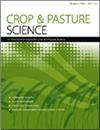Effects of cyanogenesis on morphology and estimated leaf flavonoid content in 51 white clover accessions
IF 1.8
4区 农林科学
Q2 AGRICULTURE, MULTIDISCIPLINARY
引用次数: 0
Abstract
Abstract Context. Plant secondary metabolites are of increasing interest for agriculture due to their diverse beneficial ecological functions. The forage crop white clover (Trifolim repens L.) has been intensively studied for its heritable polymorphism in the production of hydrogen cyanide (HCN), a toxic defense phytochemical. In fodder production, white clover accessions are selected for biomass production, whereby HCN production is an unwanted trait. Aim. Although white clover is a legume crop species of global importance, little is known about the linkage between cyanogenesis and growth traits, in particular in combination with resistance-related phytochemicals, such as flavonoids. We aimed to identify differences in biomass production, estimated leaf flavonoid content, and trait correlations in cyanogenic (HCN-producing) and acyanogenic (not HCN-producing) individuals and accessions of white clover. Methods. We analysed 51 white clover accessions from a German germplasm collection for variability in selected traits: cyanogenesis as equivalent electrode potential, estimated leaf flavonoid content, root and shoot production, leaf area, specific leaf area, and number of leaves produced. Key results. Most accessions considered as cyanogenic were heterogeneous for HCN production. Chemical–morphological trait correlations differed between cyanogenic and acyanogenic plants. Acyanogenic individuals and accessions produced more and larger leaves compared to cyanogenic ones. Within cyanogenic accessions, the higher the HCN level of a plant, the fewer but larger leaves were produced. Conclusions. Our results highlight the variation in HCN production within the selected accessions, which calls for a consistent approach for cyanogenesis-based categorisation. Implication. This study demonstrates the potential of combining phytochemical traits with biomass production in white clover when selecting material in a breeding program.氰化对51份白三叶草形态及叶片类黄酮含量的影响
抽象的上下文。植物次生代谢物由于具有多种有益的生态功能而越来越受到农业领域的关注。饲料作物白三叶草(Trifolim repens L.)因其产生毒性防御植物化学物质氰化氢(HCN)的遗传多态性而被广泛研究。在饲料生产中,白三叶草被选择用于生物质生产,因此HCN生产是一个不需要的性状。的目标。尽管白三叶草是一种具有全球重要性的豆科作物,但人们对白三叶草发生与生长性状之间的联系知之甚少,特别是与抗性相关的植物化学物质(如黄酮类化合物)的结合。我们的目的是鉴定产氰(产生hcn)和不产氰(不产生hcn)个体和白三叶草的生物量、叶片类黄酮含量和性状相关性的差异。方法。我们分析了51份来自德国种质收集的白三叶草的变异特征:等效电极电位、估计叶片类黄酮含量、根和芽产量、叶面积、比叶面积和叶片产量。关键的结果。大多数被认为是产氰的材料在HCN生产上是异质的。致氰植物与无氰植物的化学形态性状相关性存在差异。无氰个体和材料比有氰个体和材料产生更多更大的叶片。在含氰材料中,植株的HCN水平越高,叶片越少,但叶片越大。结论。我们的研究结果突出了所选植物中HCN产生的变化,这要求采用一致的方法进行基于氰化物生成的分类。暗示。本研究表明,在选育材料时,将植物化学性状与生物量产量相结合是白三叶草育种的潜力。
本文章由计算机程序翻译,如有差异,请以英文原文为准。
求助全文
约1分钟内获得全文
求助全文
来源期刊

Crop & Pasture Science
AGRICULTURE, MULTIDISCIPLINARY-
CiteScore
4.20
自引率
15.80%
发文量
111
审稿时长
3 months
期刊介绍:
Crop and Pasture Science (formerly known as Australian Journal of Agricultural Research) is an international journal publishing outcomes of strategic research in crop and pasture sciences and the sustainability of farming systems. The primary focus is broad-scale cereals, grain legumes, oilseeds and pastures. Articles are encouraged that advance understanding in plant-based agricultural systems through the use of well-defined and original aims designed to test a hypothesis, innovative and rigorous experimental design, and strong interpretation. The journal embraces experimental approaches from molecular level to whole systems, and the research must present novel findings and progress the science of agriculture.
Crop and Pasture Science is read by agricultural scientists and plant biologists, industry, administrators, policy-makers, and others with an interest in the challenges and opportunities facing world agricultural production.
Crop and Pasture Science is published with the endorsement of the Commonwealth Scientific and Industrial Research Organisation (CSIRO) and the Australian Academy of Science.
 求助内容:
求助内容: 应助结果提醒方式:
应助结果提醒方式:


